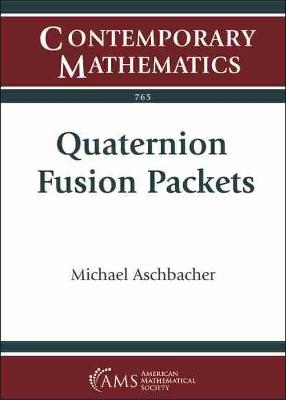
Quaternion Fusion Packets
Seiten
2021
American Mathematical Society (Verlag)
978-1-4704-5665-8 (ISBN)
American Mathematical Society (Verlag)
978-1-4704-5665-8 (ISBN)
Provides a characterization of the 2-fusion systems of the groups of Lie type and odd characteristic, a result analogous to the Classical Involution Theorem for groups. The theorem is the most difficult step in a two-part program.
Let $p$ be a prime and$S$ a finite $p$-group. A $p$-fusion system on $S$ is a category whose objects are the subgroups of $S$ and whose morphisms are certain injective group homomorphisms. Fusion systems are of interest in modular representation theory, algebraic topology, and local finite group theory. The book provides a characterization of the 2-fusion systems of the groups of Lie type and odd characteristic, a result analogous to the Classical Involution Theorem for groups. The theorem is the most difficult step in a two-part program. The first part of the program aims to determine a large subclass of the class of simple 2-fusion systems, while part two seeks to use the result on fusion systems to simplify the proof of the theorem classifying the finite simple groups.
Let $p$ be a prime and$S$ a finite $p$-group. A $p$-fusion system on $S$ is a category whose objects are the subgroups of $S$ and whose morphisms are certain injective group homomorphisms. Fusion systems are of interest in modular representation theory, algebraic topology, and local finite group theory. The book provides a characterization of the 2-fusion systems of the groups of Lie type and odd characteristic, a result analogous to the Classical Involution Theorem for groups. The theorem is the most difficult step in a two-part program. The first part of the program aims to determine a large subclass of the class of simple 2-fusion systems, while part two seeks to use the result on fusion systems to simplify the proof of the theorem classifying the finite simple groups.
Michael Aschbacher, California Institute of Technology, Pasadena, CA
Background and overview: Introduction
The major theorems and some background
Basics and examples:
Some basic results
Results on $/tau$
$W(/tau)$ and $M(/tau)$
Some examples
Theorems 2 through 5: Theorems 2 and 4
Theorems 3 and 5
Coconnectedness: $/tau^{/circ}$ not coconnected
Theorem 6: $/Omega =/Omega(z)$ of order 2
$/vert/Omega(z)/vert>2$
Some results on generation
$/vert/Omega(z)/vert=2$ and the proof of Theorem 6
Theorems 7 and 8: $/vert/Omega(z)/vert=1$ and $/mu$ abelian
More generation
$/vert/Omega(z)/vert=1$ and $/mu$ nonabelian
Theorem 1 and the Main Theorem: Proofs of four theorems
References and Index: Bibliography
Index.
| Erscheinungsdatum | 28.04.2021 |
|---|---|
| Reihe/Serie | Contemporary Mathematics |
| Verlagsort | Providence |
| Sprache | englisch |
| Maße | 178 x 254 mm |
| Gewicht | 794 g |
| Themenwelt | Mathematik / Informatik ► Mathematik ► Algebra |
| Mathematik / Informatik ► Mathematik ► Geometrie / Topologie | |
| ISBN-10 | 1-4704-5665-6 / 1470456656 |
| ISBN-13 | 978-1-4704-5665-8 / 9781470456658 |
| Zustand | Neuware |
| Haben Sie eine Frage zum Produkt? |
Mehr entdecken
aus dem Bereich
aus dem Bereich
Buch | Softcover (2022)
Springer Spektrum (Verlag)
39,99 €


